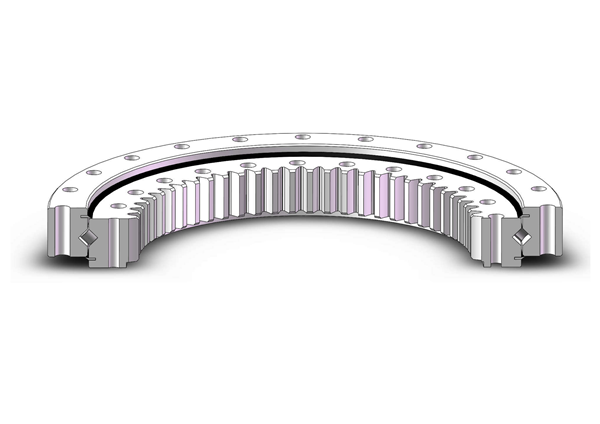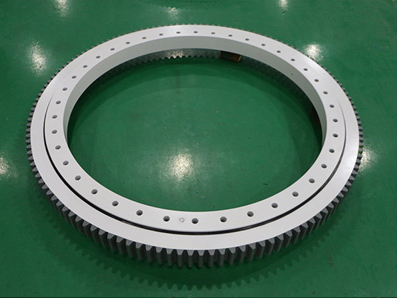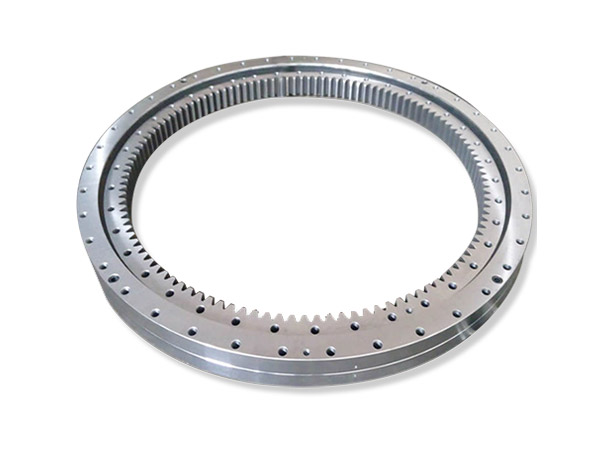Todas las máquinas experimentarán desgaste después de un largo período de uso. Cuando las piezas excedan la vida útil o estén dañadas sin posibilidad de reparación, deben desecharse y reemplazarse. El cojinete de giro de la grúa torre es propenso a fallas y daños en ambientes hostiles al aire libre a largo plazo y operaciones de alta carga, entonces, ¿hasta qué punto cumple con el estándar de desguace del cojinete de giro de la grúa torre?
Chatarra estándar de cojinete de giro de grúa torre

1. Desgaste y desechos del anillo de la pista de rodadura y del elemento rodante del cojinete de giro
El desgaste de los anillos de rodadura y los elementos rodantes es una de las formas comunes de rodamientos de gran tamaño desechados. Cuando hay picaduras en la pista de rodadura en la superficie del cojinete de giro, descamación del metal de la superficie y desgaste general, se producirán ruidos anormales, atascos en los elementos rodantes y espacio libre excesivo entre los anillos de la pista de rodadura durante el funcionamiento de la grúa torre, lo que provocará vibraciones e impactos locales. Con el desarrollo del estado, la resistencia al giro seguirá aumentando y la función de giro se perderá.
2. La jaula del cojinete de giro está dañada y desechada
Para evitar la fricción mutua entre los elementos rodantes, el cojinete de giro de la grúa torre suele añadir una jaula espaciadora entre los elementos rodantes. El material de la jaula es generalmente cobre, plástico, pulvimetalurgia o acero dulce. Durante el proceso de trabajo del rodamiento, la jaula no transmite la carga, sino que se desplaza con los elementos rodantes. Cuando la jaula está dañada o rota, habrá un sonido anormal agudo y penetrante. Como el cuerpo roto de la jaula es empujado y rodado por el cuerpo rodante giratorio, causará daños graves al anillo de la pista de rodadura y al cuerpo rodante. En este momento, el cojinete de giro cumple con el estándar de desecho y se puede reemplazar.
3. Los dientes del engranaje del cojinete de giro están dañados y desechados
Los métodos de engrane de engranajes del cojinete de giro de grúa torre incluyen engrane de dientes externo y engrane de dientes interno. Cuando la superficie de los dientes del engranaje está excesivamente desgastada, se producen grietas y dientes rotos. La holgura del lado del diente de los dientes del engranaje del cojinete de giro de la grúa torre aumenta, lo que hace que el cojinete de giro pierda su función inmediatamente cuando se rompe el diente y no se puede reparar. En este momento, se alcanza el estándar de desguace del cojinete de giro de la grúa torre.
4. Los pernos de conexión del cojinete de giro están dañados y desechados
Aunque el perno de conexión del cojinete de giro no es el cuerpo del cojinete, la falla del perno también hará que el cojinete de giro no funcione. El daño de los pernos de conexión en el trabajo con grúa torre también es un fenómeno común. Cuando un perno de conexión de un cojinete de giro se afloja o se rompe, a menudo provoca una reacción en cadena de aflojamiento y rotura de otros pernos. En este momento, también se debe reemplazar el cojinete de giro.
5. El cojinete de giro está desechado debido a daños por corrosión y quemaduras
Debido al complejo entorno de trabajo del cojinete de giro de la grúa torre, la situación que puede encontrar el cojinete también es impredecible. Si se corroe con sustancias corrosivas como ácidos y álcalis durante el funcionamiento, dañará los componentes internos del rodamiento y hará que se deseche.
Vida útil del cojinete de giro de la grúa torre

Bajo una determinada carga, el número de revoluciones u horas que experimenta un rodamiento antes de que se produzcan picaduras se denomina vida útil del rodamiento. La vida útil del cojinete de giro de la grúa torre se ve afectada por la velocidad de rotación, la carga radial, la carga nominal básica, el cumplimiento equivalente, el coeficiente de velocidad y el coeficiente de vida a la fatiga.
1. Fórmula de cálculo de la vida útil del rodamiento.
L10–Cuando la carga del rodamiento es P, la vida nominal básica (106 revoluciones)
C–Clasificación de carga dinámica básica N
ε–índice
Cojinete de bolas: ε=3
Cojinete de rodillos: ε=10/3
P-carga dinámica equivalente (N)
La carga sobre el rodamiento en condiciones reales: A, R, convertida en la carga en condiciones experimentales se denomina carga dinámica equivalente. Para los componentes del rodamiento, esta carga es variable. Durante el estudio experimental, la vida útil del rodamiento es de 106 vueltas a La unidad es más conveniente (contador), pero en la producción real, la vida útil general se expresa en horas, por lo que es necesario convertir L10×106=Lh×60n.

2. Método de cálculo de la vida útil del cojinete de giro de la grúa torre
(1) Conociendo el tipo de rodamiento, la carga y la velocidad del eje, calcule Lh;
(2) Conociendo la carga, la velocidad y la esperanza de vida, calcule C y seleccione el modelo de rodamiento.
Por lo general, el límite medio de reparación o revisión de la máquina se toma como la vida útil de diseño del rodamiento, generalmente Lh’=5000, y se debe introducir el coeficiente de temperatura ft para el rodamiento que trabaja a alta temperatura.
Ct=ftC
t≤120 125 150 200 300
pies 1 0,95 0,90 0,80 0,60
Lo anterior es el contenido relevante sobre el estándar de desguace del cojinete de giro de la grúa torre. La grúa torre puede afectar su vida útil debido a su entorno de uso complejo. Al mismo tiempo, un buen mantenimiento y reparación también pueden prolongar la vida útil del cojinete de giro de la grúa torre.







